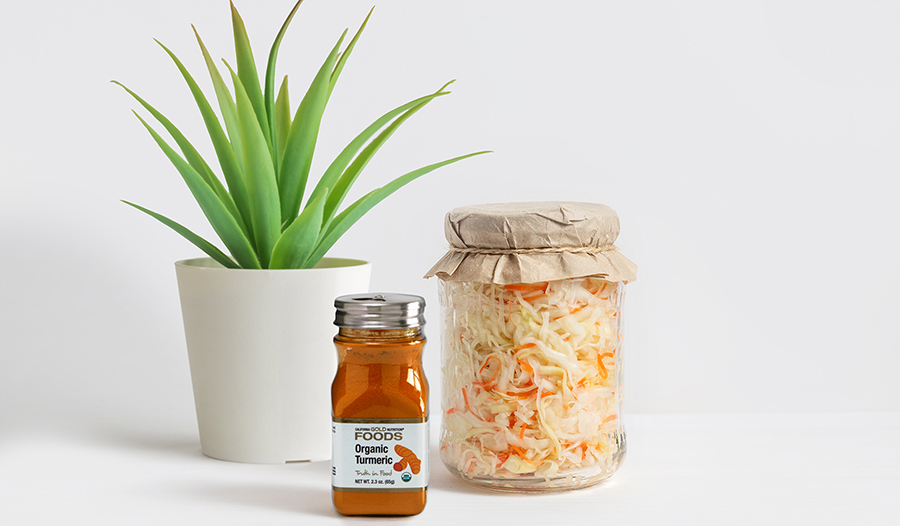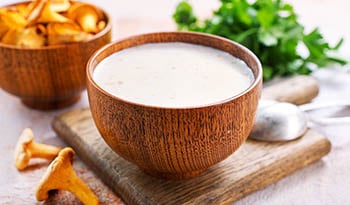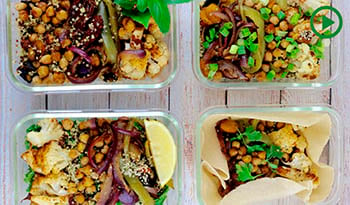5 Nutrition-Packed Recipes to Boost Your Immune System
DISCLAIMER:This blog does not intend to provide diagnosis...
- In this article:
- How Does the Immune System Work?
- What Compromises the Immune System?
- How Does Proper Nutrition Support My Immune System?
- What Are Some Recipes I Can Make to Support My Immune System?

How Does the Immune System Work?
Everyone knows the immune system protects our body from infections; exactly how it works reflects more of a mystery. The immune system has two parts: the innate and adaptive immune systems. Each part comprises unique components and functions in different ways to protect our bodies.
The innate part of our immune system includes non-specific defenses like our skin being slightly acidic, to prevent bacteria from growing on it. The mucous that lines our mouth represents another great example of innate immunity. This slimy substance contains enzymes that kill anything bad that we eat (think: that sandwich we left out of the refrigerator).
The adaptive part of our immune system is much more specific and strategic. Rather than killing whatever it comes in contact with like the innate part of the system, this sophisticated machine includes specific cells like T and B lymphocytes. These cells have specific receptors that recognize when foreign substances enter the body like viruses or bacteria.
T cells have specific receptors that help them identify these pathogens and mount an attack against them from the immune system. The interesting B cells can cover pathogens with antibodies much like we cover French fries with ketchup to make them tastier. Antibody-covered bacteria or viruses become “very tasty” to the immune system and can easily be destroyed. End game: our body has protected us, and we don’t get sick!
What Compromises the Immune System?
Seasonal Changes
Some research points to a decrease in daylight as seasons change correlating with immune function. With shorter days, some innate immune system cells don’t function as strongly as they would with longer exposure to sunlight. This research also showed a larger increase in pathogenic bacteria since part of the immune system isn’t functioning as strongly as it should.
Stress
Increased stress usually means an elevation in the stress hormone, cortisol. This elevation in cortisol has different effects on our immune system depending on the duration of the stress. With short-term stress, the innate part of our immune system gets stimulated while the adaptive gets suppressed. So with stress, our immune system gets altered, leading to less protection for the body.
Elevated cortisol stimulating the immune system can lead to a high inflammatory response in the body. Often with high cortisol comes the release of pro-inflammatory cytokines. These molecules can increase the level of intensity of an inflammatory response, signaling our immune system to deploy or create immune cells. A high inflammatory response has been theorized to be the foundation for many factors that can lead to poor health and/or fatigue — as deploying many immune cells uses a lot of energy!
Diet
Remember that old saying, “you are what you eat”? Well, it’s true! Our diet plays a big role in the health of our immune system. Micro (think vitamins and minerals) and macro (think proteins, carbohydrates, and fats) nutrients play a role in supporting a healthy immune system. Many key minerals like zinc support both the innate and adaptive immune systems. Other vitamins like vitamin E can provide antioxidant support to prevent damage to the body when we consume junk foods that naturally stimulate a high inflammatory response. Vitamin E can also help with the creation of immune components including cells themselves.
Sleep
Sleep also plays a significant role in immune function. If we don’t respect our circadian rhythms — the natural cues from our body to go to bed around 11 p.m. and wake around 7 a.m. — or if we toss and turn at night, this can increase our cortisol and can impact our immune function. Lack of quantity and quality of sleep can disturb our immune system, leading to increased susceptibility to infection.
How Does Proper Nutrition Support My Immune System?
In addition to vitamins supporting the immune system, proper nutrition found in a variety of foods and herbs proves critical. The immune system symbolizes an army of fighters. If the system was a group of living breathing soldiers, it would need resources to keep it functioning well. It would need weapons, shelter, and food (energy).
The energy needed to power the immune system comes from the foods we eat. It takes a substantial amount of energy to power each cell comprising our vast immune system. Let’s dive into some key immune supporters featured in the recipes below.
Bay Leaf
Bay leaf or Lauris nobilis represents a shrub and common kitchen spice with antioxidant and immune-supportive properties. This spice has been studied to support healthy immune function, allowing the immune system to react to pathogens while preventing the system from overreacting.
Dill
Dill’s antioxidant properties can support the immune system indirectly by repairing the damage done to the body and prevent immune system overreaction.
Cayenne
Cayenne pepper, a common spice, gives any dish a little “kick” of flavor. The main active ingredient in any hot pepper, bio-active capsaicin, has been proven to have immune-modulatory effects — essentially making our innate and adaptive immune systems more robust and able to fight against infection efficiently.
Ginger
Ginger, known for its pungent bitter taste, is often used in baking or as an addition to Asian cuisine. This herb packs a powerful immune-supportive element (through regulating an inflammatory response) as well as antioxidant benefits.
Mint
Mint or peppermint represents a very common herb seen in a variety of dishes and candies. The immune-boosting properties found in the mint leaf oils, although not well known, have been found to enhance adaptive immunity and remain innately anti-microbial themselves.
Turmeric
Turmeric root contains curcumin. Curcumin extract represents a well-known immunomodulator. Its main bio-actives, curcuminoids, work to make immune signaling more efficient and support the creation of cells in both the innate and adaptive parts of the immune system.
What Are Some Recipes I Can Make to Support My Immune System?
Many foods and herbs have immune supportive properties. These recipes include dill-infused homemade pickles, borscht, carrot ginger soup, white bean soup, and turmeric sauerkraut.
1. Homemade Pickle Recipe
Prep time: 15 minutes
Total time: 1-3 hours
Ingredients:
- 12 ounces of cucumbers
- ½ cup of water
- ½ cup apple cider vinegar
- 1 Tbsp. maple syrup
- 1 tsp. of salt
- ½ tsp. red pepper flakes
- ½ tsp. black pepper ground
- ¼ cup fresh dill
- 2 cloves garlic
- 1 Bay leaf
- 1 12-16 oz. mason jar
Instructions:
- Slice cucumbers into circles or long spear shapes.
- In a medium-sized bowl, combine water, vinegar, maple syrup, salt, red pepper flakes, and black pepper.
- Stir until salt dissolves.
- Dice the garlic into small pieces.
- Place the cucumbers into the mason jar and cover with a liquid mixture.
- Add bay leaf and dill and refrigerate for 1 hour (if using circular cucumbers) or 3 hours (if using spear-shaped cucumbers).
2. Borscht Recipe
Prep Time: 15 mins
Cook Time: 25 minutes
- 2 Tbsp. olive oil
- 1 medium onion diced
- 6 cloves of garlic chopped
- 2 stalks of celery chopped
- 1 cup of carrots diced
- 2 cups of diced beets
- 2 cups shredded cabbage
- 4 cups of vegetable broth
- 2 Tbsp. of tomato paste
- 1 tsp. celery seed
- ½ tsp. of allspice
- 2 tsp. salt
- ½ tsp. pepper
- ½ tsp. cayenne pepper
- 2 Tbsp. apple cider vinegar
- ½ cup fresh dill chopped
Instructions:
- Heat olive oil in a large Dutch oven pan and sauté onions until golden brown.
- Add garlic, celery, carrots, beets, and cabbage.
- Stir to cover in olive oil.
- Add broth and tomato paste.
- Add spices, salt, and pepper.
- Cover and simmer until beets and carrots become tender.
3. Carrot Ginger Soup Recipe
Prep Time: 10 mins
Cook Time: 20 mins
Ingredients:
- 1 Tbsp. olive oil
- 1 yellow onion diced
- 1 lb. carrots cut into circular rounds
- 1-inch piece of ginger diced
- ½ tsp. salt
- 4 cups vegetable broth
- 1 cup of coconut milk
- Dash of black pepper
Instructions:
- Heat a large soup pot over medium-high heat.
- Add olive oil, onion, and carrots. Sauté for 5 minutes.
- Add ginger and turmeric for 2 additional minutes. Add broth and salt.
- Bring to a boil and then turn the heat down and simmer for 20 minutes.
- Blend with an immersion blender and add coconut milk.
- Garnish with black pepper.
4. White Bean Dip Recipe
Prep Time - 10 minutes
Cook Time - 5 minutes
Ingredients:
- 1 14 oz. can of cannellini beans
- 1 clove garlic
- 1 Tbsp. olive oil
- 1 Tbsp. dried mint
- 1 Tbsp. thyme
- 3 Tbsp. chives
- Pinch of salt and pepper
Instructions:
- Blend all ingredients into a purée.
- Top with chives and serve on toasted baguette slices.
5. Turmeric Sauerkraut Recipe
Prep Time: 15 mins
Ingredients:
- 1 lb. shredded cabbage
- ½ onion sliced
- 2 cloves of garlic minced
- 1 tsp. salt
- 1 tsp. ginger
- ½ tsp. dried turmeric
- 1 14-16 oz. mason jar
Instructions:
- Chop cabbage and place in a bowl.
- Add salt and massage into the cabbage,
- Add onion, garlic, and ginger and toss,
- Add mixture to a mason jar and make sure to cover the cabbage mixture with liquid.
- Cover loosely with a lid and place on the counter for 4-5 days to stimulate fermentation.
- The longer you ferment, the more the flavors will meld, and the cabbage will become softer.
Thankfully, at a time when our immune systems face increased vulnerability, there exists lifestyle and supplement best practices that can support our system when it needs it the most!
References:
- Yatim KM, Lakkis FG. A brief journey through the immune system. Clin J Am Soc Nephrol. 2015;10(7):1274-1281. doi:10.2215/CJN.10031014
- Gassen J, Proffitt Leyva RP, Mengelkoch S, et al. Day length predicts investment in human immune function: Shorter days yield greater investment. Psychoneuroendocrinology. 2019;107:141-147. doi:10.1016/j.psyneuen.2019.05.011
- Segerstrom SC, Miller GE. Psychological stress and the human immune system: a meta-analytic study of 30 years of inquiry. Psychol Bull. 2004;130(4):601-630. doi:10.1037/0033-2909.130.4.601
- Brown MM, Bell DS, Jason LA, Christos C, Bell DE. Understanding long-term outcomes of chronic fatigue syndrome. J Clin Psychol. 2012;68(9):1028-1035. doi:10.1002/jclp.21880
- Childs CE, Calder PC, Miles EA. Diet and Immune Function. Nutrients. 2019;11(8):1933. Published 2019 Aug 16. doi:10.3390/nu11081933
- Missiroli, S., Genovese, I., Perrone, M., Vezzani, B., Vitto, V., & Giorgi, C. (2020). The Role of Mitochondria in Inflammation: From Cancer to Neurodegenerative Disorders. Journal of clinical medicine, 9(3), 740.
- Besedovsky L, Lange T, Haack M. The Sleep-Immune Crosstalk in Health and Disease. Physiol Rev. 2019;99(3):1325-1380. doi:10.1152/physrev.00010.2018
- Childs CE, Calder PC, Miles EA. Diet and Immune Function. Nutrients. 2019;11(8):1933. Published 2019 Aug 16
- Batool S, Khera RA, Hanif MA, Ayub MA. Bay Leaf. Medicinal Plants of South Asia. 2020;63-74. doi:10.1016/B978-0-08-102659-5.00005-7
- Yu R, Park JW, Kurata T, Erickson KL. Modulation of select immune responses by dietary capsaicin. Int J Vitam Nutr Res. 1998;68(2):114-119.
- Mashhadi NS, Ghiasvand R, Askari G, Hariri M, Darvishi L, Mofid MR. Anti-oxidative and anti-inflammatory effects of ginger in health and physical activity: review of current evidence. Int J Prev Med. 2013;4(Suppl 1):S36-S42.
- Adel M, Abedian Amiri A, Zorriehzahra J, Nematolahi A, Esteban MÁ. Effects of dietary peppermint (Mentha piperita) on growth performance, chemical body composition and hematological and immune parameters of fry Caspian white fish (Rutilus frisii kutum). Fish Shellfish Immunol. 2015;45(2):841-847. doi:10.1016/j.fsi.2015.06.010
- Catanzaro M, Corsini E, Rosini M, Racchi M, Lanni C. Immunomodulators Inspired by Nature: A Review on Curcumin and Echinacea. Molecules. 2018;23(11):2778. Published 2018 Oct 26. doi:10.3390/molecules23112778
- Taylor K. Easy Homemade pickles. Cookie + Kate website. August 5, 2020. Accessed January 2, 2021. https://cookieandkate.com/best-pickles-recipe/
- Fountaine S. Simple borscht recipe. Feasting At Home website. February 22, 2019. Accessed December 28, 2020. https://www.feastingathome.com/borscht/
- Gold S. Carrot-ginger immune-boosting soup (Instant Pot). Sarah Gold Nutrition website. November 21, 2018. Accessed December 28, 2020. www.sarahgoldrd.com/immune-boosting-carrot-ginger-soup-instant-pot/
- Fountaine S. How to make turmeric sauerkraut. Feasting at Home website. April 13, 2017. Accessed December 28, 2020. https://www.feastingathome.com/turmeric-sauerkraut/
- Ray R. White bean dip. The Food Network website. Accessed January 1, 2021. https://www.foodnetwork.com/recipes/rachael-ray/white-bean-dip-recipe-1939452

 By Dr. Melissa Anzelone, N.D.
By Dr. Melissa Anzelone, N.D.


